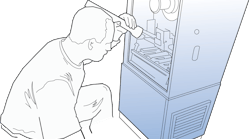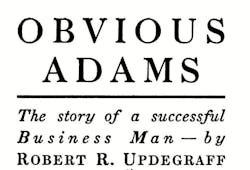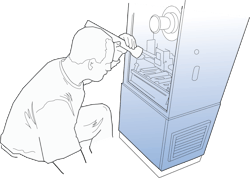Contracting Business
The April 1916 issue of The Saturday Evening Post published The Story of Obvious Adams. This fictional short story introduced readers to an unassuming young man who eventually became a legend in the advertising business. Oliver (Obvious) Adams started slowly, and company management often overlooked him. However, the company president soonThe story is more than 100 years old, but the principles are timeless. It is a cautionary tale of overthinking and missing problems in plain sight. Obvious Adams used five approaches to avoid these pitfalls that are as relevant to HVAC as they are advertising.
In our industry, comfort complaints are at an all-time high. They are one of your client's most challenging problems, and they're looking to you for answers. Instead of focusing on the HVAC equipment as the solution, is there another way possible? Let's look at how you might approach a comfort complaint using Obvious Adams's methods.
Consider the Customer's Point of View
Obvious Adams started by looking at a problem from the customer's perspective rather than the perspective of an advertising man. He would engage the customer and put himself in their shoes to experience what they experienced. He wanted to see things from their point of view.
It's easy to get wrapped up going from call to call and forget the customer is the one whoYour appearance is probably the easiest to overlook. It's the last thing you're thinking about after finishing up in a 130F attic. Your shirt is sweaty, and you probably don't smell like a rose. All you want is to cool down and get a drink. The customer at this call gets it. They know what you just endured.
Instead of assuming the problem, the better approach is to ask the customer questions to learn what's happening. No one knows their home better, and they will often have clues to point you in the right direction.
However, the next customer you visit doesn't. Their first impression begins as soon as you pull into their driveway and knock on the door. Small things like your cleanliness, where you park, your attitude, and respect for their property are all obvious but often the last things you focus on.
Good communication is another detail that's easy to miss. Instead of assuming the problem, the better approach is to ask the customer questions to learn what's happening. No one knows their home better, and they will often have clues to point you in the right direction.
Once you discover the problem, explanations offered to the customer should be simple, relatable, and easy to understand. Any concept requiring a detailed, abstract explanation won't connect with the customer.
Start with the Obvious
When Obvious Adams arrived at a business, he would start with the obvious. For him, the obvious included product placement and advertising displays. Next, he made an overall assessment before diving into details or offering suggestions.
Following the Obvious Adams approach, you would start with a scan for discomfort clues. These clues are everywhere if you know where to look.
In the cooling season, it's common to hear complaints that one part of the home is too hot to use. These "parts" range from bedrooms to entire second floors. To offset the heat in these areas, you'll often find the following signs:
- Portable room fans
- Register scoops
- Window air conditioning units
- Window shades.
Many customers are so accustomed to using these things that they forget about them.
How frequently do you see these items in a home and walk past them? Are they truly a solution, or do they demonstrate that your customers need help? It's easy to overlook the obvious and head straight for the HVAC equipment. When you follow the Obvious Adams approach, you look for clues.
Consider the Bigger Picture
Obvious Adams didn't have tunnel vision. As he entered a business, he would consider the bigger advertising picture of how everything worked together. The bigger picture included slogans, positioning, business location, and even customer walking patterns through a store. These seemingly disconnected details all factored into Obvious Adams's solutions for his clients.
After scanning for discomfort clues, always consider the entire HVAC system during a comfort complaint. It should start with the HVAC equipment but not stay there. That's because you understand the equipment is just one component of a much bigger system.
If there's a problem with the building enclosure, even a perfect installation won't be able to offset it.
Once the equipment inspection is complete, the duct system is the next stop. It delivers heating and cooling from the equipment into the living space. If there is a problem with this part of the system, it doesn't matter how exceptional the equipment is - comfort will suffer.
After you finish the duct system inspection, it's time to examine the final piece of the HVAC system. The building enclosure serves as a container for the airflow and temperature the HVAC system delivers. If there's a problem with this part of the HVAC system, even a perfect installation won't be able to offset it.
Test, Not Guess
Obvious Adams would test his advertising ideas with clients to see what worked and then adjust his approach based on feedback. In other words, he tested but never guessed. Testing focuses on the issue at hand and addressing facts. It kept Obvious Adams hunting for the obvious and away from the obscure.
When you follow the Obvious Adams approach, you use testing to make comfort problems visible. The results would provide essential clues to diagnose the system based on current conditions. Discovering these issues involves testing a system differently than your competitors do. A refrigeration manifold is not your first choice. Instead, a manometer and psychrometer are your go-to test instruments.
Static pressure and system temperatures are the most effective and simple tests. They reveal the obvious that is otherwise hidden. Use static pressure to discover restricted ducts and low airflow conditions. Use system temperatures to expose excessive temperature loss across a duct system. Once you gather these measurements, ask customers questions related to their problems.
Keep Learning
Obvious Adams was a lifelong learner who spent his spare moments looking for new ways to solve impossible problems. He knew the answer was obvious but hadn't seen it from the right angle yet.
You, too, will remain a student and lifelong learner when you follow the Obvious Adams example. You're always looking for simple ways to improve. Look for new information that helps you solve daily challenges and discover new ways to apply new knowledge.
You'll ask many "What if?" questions and challenge yourself to excel to the best of your ability. Beer-Thirty isn't on your timeline. That's because you don't confine learning to the workplace. You also study on your own time.
Obvious Isn't Easy
It's hard to apply the obvious approach. The obscure is exciting, spicy, and usually clever and complex. The obvious is bland. Yet it's straightforward once you discover it.
The obvious will always explode in your customer's minds. The solution is so simple they will wonder why they haven't seen it before. One of my favorite examples of such an obvious epiphany occurred at a private onsite training event I did years ago.
The home we tested had an uncomfortable bonus room that doubled as the wife's office. She rarely used the room because it was so hot in the summer and cold in the winter. The first diagnosis by many students was the room needed an additional heat pump system.
After a visual inspection and testing, we discovered the bonus room was only getting half the airflow needed. We also found excessive heat coming into the room because of knee wall and underfloor insulation defects.
With some duct renovation and insulation repair, the bonus room temperature rapidly dropped. The homeowners couldn't believe the difference after we finished. It also surprised the students how we corrected the issue without installing equipment. They now had a new and obvious way of looking at an HVAC system.
Chris Voss, the author of Never Split the Difference, wrote, "Don't look to verify what you expect. If you do, that's what you'll find. Instead, you must open yourself up to the factual reality that is in front of you."
Now it's your turn. What is an obvious comfort problem you regularly encounter that has you puzzled? What is in plain sight that you're missing or possibly overthinking? Why not identify it and develop a practical solution to serve your customers? You could eventually become a legend in your market, just like Obvious Adams.
David Richardson serves the HVAC industry as Director of Training for the National Comfort Institute, Inc. (NCI). NCI specializes in training focusing on improving, measuring, and verifying HVAC and Building Performance.
If you're an HVAC contractor or technician interested in uncovering obvious comfort problems, contact David at ncilink.com/ContactMe. NCI's website, www.nationalcomfortinstitute.com, is full of free information to help you improve your professionalism and strengthen your company.











